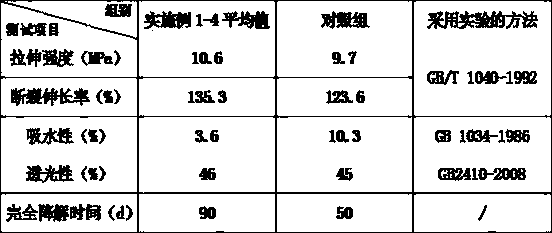Biodegradable peanut protein plastic with long service life
A biodegradable, peanut protein technology, applied in the field of plastics, can solve the problems of low water absorption, high brittleness, low tensile strength, etc., to improve tensile and impact resistance, improve wear resistance and tear resistance, The effect of improving oxidation resistance
- Summary
- Abstract
- Description
- Claims
- Application Information
AI Technical Summary
Problems solved by technology
Method used
Image
Examples
Embodiment 1
[0013] The present invention proposes a long service life and biodegradable peanut protein plastic, whose raw materials include by weight: 35 parts of hydroxybutyric acid valeric acid copolyester PHBV, 55 parts of modified poly-β-hydroxybutyric acid PHB, peanut 20 parts of protein powder, 15 parts of nanocellulose whiskers, 4 parts of amylose, 1.1 parts of silane coupling agent KH590, 3 parts of sodium lactate, 0.5 parts of sodium dehydroacetate, 2.3 parts of dioctyl terephthalate DOTP, cyclo 2 parts of octyl oxystearate, 28 parts of carbon black N550, 12 parts of heavy calcium carbonate, 7 parts of kaolin, 11 parts of hard clay, 0.7 parts of antioxidant, wherein the modified poly-β-hydroxybutyrate PHB is poly- It is obtained by blending and modifying β-hydroxybutyric acid PHB and ethylene-propylene rubber, and the antioxidant is composed of antioxidant RD and antioxidant 168;
[0014] During the preparation process, the silane coupling agent KH590 was added to the nanocellulo...
Embodiment 2
[0016] The present invention proposes a long service life biodegradable peanut protein plastic, its raw materials include by weight: 30 parts of hydroxybutyric acid valeric acid copolyester PHBV, 60 parts of modified poly-β-hydroxybutyric acid PHB, peanut protein 15 parts of powder, 18 parts of nanocellulose whiskers, 5 parts of amylose, 1.3 parts of silane coupling agent KH590, 2 parts of sodium lactate, 0.8 parts of sodium dehydroacetate, 1.7 parts of dioctyl terephthalate DOTP, epoxy 4 parts of octyl stearate, 25 parts of carbon black N550, 16 parts of heavy calcium carbonate, 4 parts of kaolin, 10 parts of hard clay, 0.9 parts of antioxidant, wherein the modified poly-β-hydroxybutyrate PHB is poly-β - Obtained by blending and modifying hydroxybutyric acid PHB and ethylene-propylene rubber, the antioxidant is composed of antioxidant RD and antioxidant 168;
[0017] During the preparation process, the silane coupling agent KH590 was added to nanocellulose whiskers and amylos...
Embodiment 3
[0019] The present invention proposes a long service life and biodegradable peanut protein plastic, whose raw materials include by weight: 34 parts of hydroxybutyric acid valeric acid copolyester PHBV, 56 parts of modified poly-β-hydroxybutyric acid PHB, peanut 19 parts of protein powder, 16 parts of nanocellulose whiskers, 4.6 parts of amylose, 1.23 parts of silane coupling agent KH590, 2.5 parts of sodium lactate, 0.6 parts of sodium dehydroacetate, 2.1 parts of dioctyl terephthalate DOTP, 2.6 parts of epoxy octyl stearate, 27 parts of carbon black N550, 13 parts of heavy calcium carbonate, 6 parts of kaolin, 12 parts of hard clay, 0.75 parts of antioxidant, wherein the modified poly-β-hydroxybutyrate PHB is poly - It is obtained by blending and modifying β-hydroxybutyric acid PHB and ethylene-propylene rubber, and the antioxidant is composed of antioxidant RD and antioxidant 168;
[0020]During the preparation process, the silane coupling agent KH590 was added to the nanoce...
PUM
 Login to View More
Login to View More Abstract
Description
Claims
Application Information
 Login to View More
Login to View More - R&D
- Intellectual Property
- Life Sciences
- Materials
- Tech Scout
- Unparalleled Data Quality
- Higher Quality Content
- 60% Fewer Hallucinations
Browse by: Latest US Patents, China's latest patents, Technical Efficacy Thesaurus, Application Domain, Technology Topic, Popular Technical Reports.
© 2025 PatSnap. All rights reserved.Legal|Privacy policy|Modern Slavery Act Transparency Statement|Sitemap|About US| Contact US: help@patsnap.com

